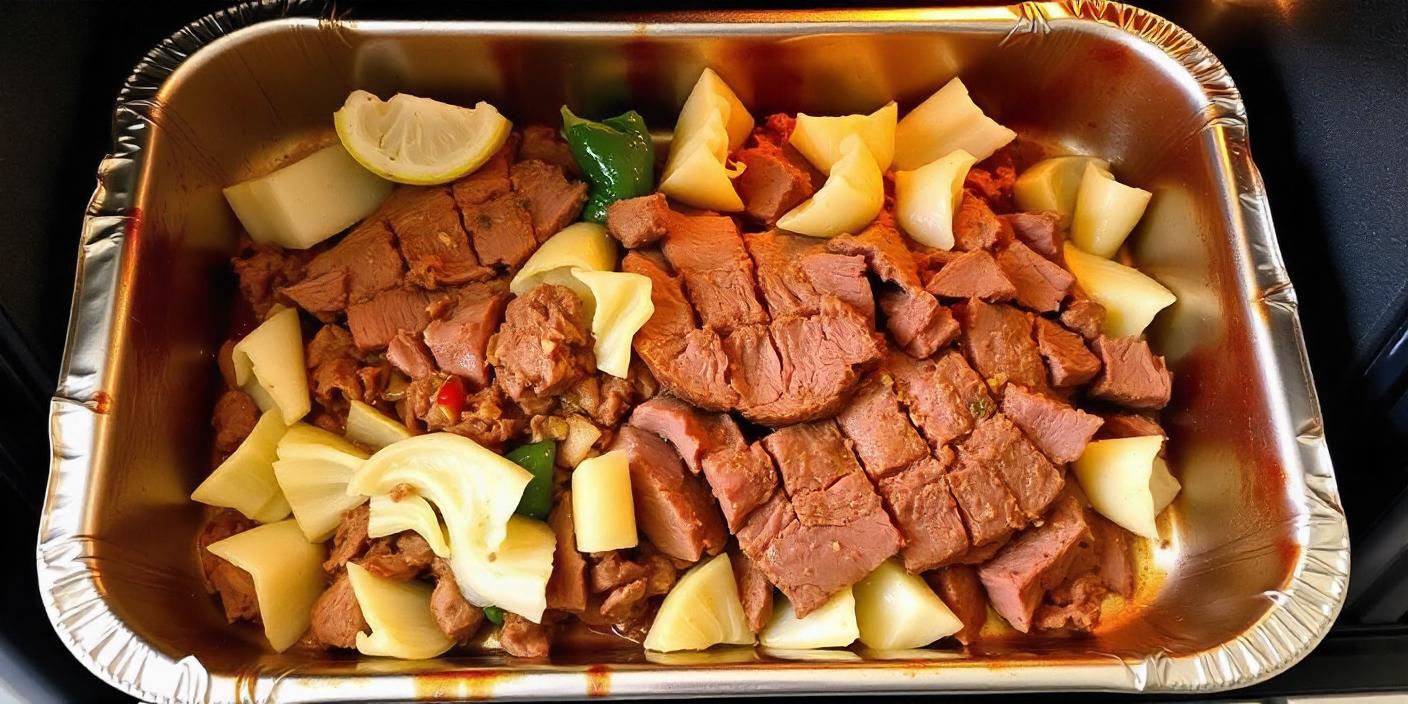Corned beef and cabbage is a timeless dish that has become synonymous with comfort food, particularly around St. Patrick’s Day. Traditionally prepared by simmering on the stovetop or slow cooking, this oven-baked version offers a hassle-free and flavorful alternative. Baking the dish in the oven allows the beef to turn out tender while the cabbage and vegetables soak up the rich flavors of the meat. In this guide, we will walk you through a detailed step-by-step process to make a delicious corned beef and cabbage recipe using your oven.
Why Make Corned Beef and Cabbage in the Oven?
When preparing corned beef and cabbage, the oven method offers several distinct advantages. Baking the dish is not only convenient but also enhances the flavors through slow roasting. Here’s why the oven is the best method:
- Even Cooking: Baking allows for even heat distribution, which ensures both the corned beef and vegetables cook thoroughly without becoming overly mushy.
- Tender Meat: The low and slow heat of the oven helps tenderize the meat, ensuring a juicy and flavorful result.
- Enhanced Flavors: Unlike boiling, which can dilute flavors, oven roasting intensifies the spices and enhances the overall taste of the dish.
Ingredients Needed for Corned Beef and Cabbage in the Oven
Here’s what you’ll need to make this delicious dish:
- 3-4 lbs of corned beef brisket (with spice packet included)
- 3 tablespoons of whole grain mustard
- 3 tablespoons of light brown sugar
- ½ teaspoon of cracked black pepper
- 1 large green cabbage, cut into wedges
- 2 large sweet onions, cut into wedges
- 2 lbs of mini new potatoes, whole or halved
- 2 lbs of carrots, peeled and chopped into 2-3 inch segments
- 8-10 cloves of garlic, peeled
Ingredient Breakdown
- Corned Beef Brisket: This is the star of the dish, and using a good-quality brisket is essential. The spice packet that comes with the brisket will enhance the flavors during cooking.
- Whole Grain Mustard and Brown Sugar: These ingredients are used to create a flavorful rub for the brisket. The mustard provides a tangy bite, while the brown sugar balances the flavors with a touch of sweetness.
- Green Cabbage and Carrots: Cabbage and carrots are classic pairings for corned beef. The cabbage soaks up the flavorful juices from the beef, while the carrots add a natural sweetness.
- Mini Potatoes: Potatoes help make this a full meal, and they roast beautifully alongside the beef and vegetables, becoming tender and flavorful.
Step-by-Step Guide to Making Corned Beef and Cabbage in the Oven
Step 1: Preheat the Oven
Start by preheating your oven to 325°F (160°C). This temperature ensures that the meat will cook slowly and evenly, which is key to achieving that fall-apart tenderness.
Step 2: Prepare the Corned Beef
Take the corned beef brisket out of its packaging and give it a quick rinse under cold water. This helps remove any excess salt from the curing process. Pat the brisket dry with paper towels and place it in a large roasting pan, fat side up.
Step 3: Make the Mustard Rub
In a small bowl, combine the whole grain mustard, light brown sugar, and cracked black pepper. Mix these ingredients together to form a paste. Rub this mixture all over the top of the corned beef brisket, ensuring an even coating. This will help form a flavorful crust on the meat as it roasts.
Step 4: Add the Spice Packet and Water
Open the spice packet that comes with the brisket and sprinkle the contents around the meat, not directly on top. Pour about 4 cups of water into the roasting pan, being careful not to wash off the mustard rub from the brisket. The water helps keep the brisket moist during cooking and will later be used to baste the vegetables.
Step 5: Cover and Bake the Corned Beef
Cover the roasting pan tightly with foil. This will trap the steam inside, ensuring the meat remains tender. Place the pan in the preheated oven and let the corned beef bake for about 2 hours.
During this time, the flavors will begin to meld together, and the meat will start to tenderize. The mustard and brown sugar rub will also create a delicious crust on top of the brisket.
Preparing the Vegetables
Step 6: Prepare the Cabbage, Carrots, and Potatoes
While the corned beef is baking, you can prepare the vegetables. Cut the green cabbage into wedges, peel and slice the carrots into segments, and halve or quarter the mini potatoes if they are large.
These vegetables will be added to the roasting pan during the final hour of cooking so they can soak up the flavorful juices from the beef.
Step 7: Add the Vegetables to the Roasting Pan
After 2 hours, remove the roasting pan from the oven and increase the oven temperature to 350°F (175°C). Carefully arrange the cabbage wedges, carrots, potatoes, and garlic cloves around the corned beef in the roasting pan. Spoon some of the pan juices over the vegetables to ensure they’re well-coated with the flavors of the beef.
Cover the pan again and return it to the oven for another 30 minutes.
Final Steps to Finish the Dish
Step 8: Roast Uncovered
After the vegetables have roasted covered for 30 minutes, remove the foil and let the dish continue cooking uncovered for an additional 30-45 minutes. This step allows the vegetables to crisp up slightly and become golden brown. Check the carrots and potatoes with a fork to ensure they are tender.
Step 9: Let the Corned Beef Rest
Once the corned beef has finished cooking, remove it from the oven and allow it to rest for about 10 minutes before slicing. This resting period lets the juices redistribute throughout the meat, ensuring that each bite is moist and flavorful.
Serving Corned Beef and Cabbage
When it comes to serving corned beef and cabbage, slice the brisket against the grain into thin strips. This will help the meat remain tender and easier to chew. Arrange the sliced corned beef on a platter alongside the roasted cabbage, carrots, and potatoes.
For a classic pairing, serve the dish with a side of whole grain mustard or creamy horseradish sauce. The tangy and slightly spicy notes from these condiments complement the richness of the beef.
Tips for Success
Here are a few tips to ensure your corned beef and cabbage in the oven turns out perfect every time:
- Rinse the Corned Beef: Always rinse the corned beef before cooking to remove excess salt from the brine. This step is especially important if you’re sensitive to salt.
- Slow and Steady Wins the Race: The key to tender corned beef is slow cooking. The low heat and extended cooking time allow the meat to break down and become tender without drying out.
- Use the Cooking Juices: Don’t let the flavorful juices go to waste! When serving, spoon some of the juices over the vegetables for added flavor.
- Leftovers: If you have leftovers, you can make a variety of delicious dishes, such as corned beef hash or corned beef sandwiches. Store leftovers in an airtight container in the refrigerator for up to 3 days.
Frequently Asked Questions
What is Corned Beef?
Corned beef is a salt-cured cut of beef, typically brisket, that has been brined in a seasoned liquid. The term “corned” comes from the large grains of rock salt (known as “corns”) that were traditionally used to preserve the meat. The process gives the beef its characteristic pink color and savory flavor.
Why is Corned Beef So Salty?
The salting process used to cure the meat naturally makes corned beef salty. However, rinsing the meat before cooking helps reduce the saltiness. If you’re particularly sensitive to sodium, you can also soak the brisket in water for an hour before cooking to draw out more salt.
Should You Cover Corned Beef While Baking?
Yes, it’s important to cover the corned beef while baking to ensure it stays moist and doesn’t dry out. The foil traps steam, which helps keep the meat tender during the long cooking process. During the final stage of roasting the vegetables, however, you’ll remove the foil to allow the vegetables to crisp up slightly.
Variations on Corned Beef and Cabbage
While the traditional corned beef and cabbage recipe is delicious on its own, there are several variations you can try:
- Different Vegetables: In addition to cabbage, carrots, and potatoes, try adding parsnips, turnips, or sweet potatoes for a unique twist.
- Spicy Corned Beef: For a bit of heat, add red pepper flakes to the mustard rub, or serve the dish with spicy mustard on the side.
- Gluten-Free Option: Ensure that the spice packet and any sauces you use are gluten-free if you’re preparing the dish for someone with gluten intolerance.
- Add Beer to the Roasting Pan: For extra flavor, add a cup of Irish stout (like Guinness) or another dark beer to the roasting pan along with the water. The beer adds depth to the flavor and enhances the overall dish.
Leftover Ideas for Corned Beef and Cabbage
One of the great things about corned beef is that the leftovers are incredibly versatile. Here are a few ways to use up any remaining corned beef:
- Corned Beef Hash: Chop up the leftover corned beef, potatoes, and onions, and fry them together in a pan until crispy. Top with a fried egg for a delicious breakfast or brunch.
- Corned Beef Sandwiches: Layer sliced corned beef with Swiss cheese, sauerkraut, and mustard on rye bread to make a classic Reuben sandwich.
- Corned Beef Tacos: For a fun twist, shred the leftover corned beef and serve it in tortillas with cabbage slaw and a drizzle of mustard or horseradish sauce.
Final Thoughts on Corned Beef and Cabbage in the Oven
This oven-baked version of corned beef and cabbage is an easy, no-fuss way to enjoy this classic dish. With tender, flavorful meat and perfectly roasted vegetables, it’s a dish that’s sure to impress. Whether you’re celebrating a holiday or simply craving a hearty meal, this recipe is one you’ll want to make again and again.
For more great meal ideas, try exploring other oven-based recipes such as smoked BBQ chicken thighs or baked seafood dishes.

